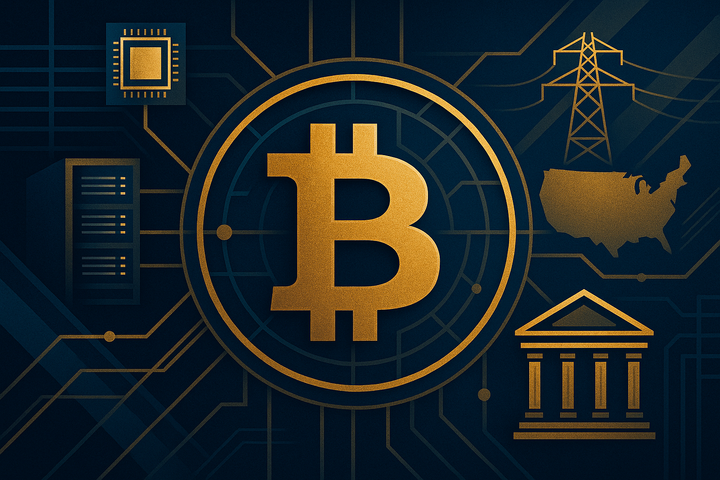Pacific Northwest Bitcoin Mining Constraints and Growth Paths
The August 12, 2025 episode of The Mining Pod features Beau Turner explaining how low-cost hydro power in the Pacific Northwest contrasts with restrictive Bonneville Power Administration rate structures and a legacy of strained utility relations.

- My 'briefing notes' summarize the content of podcast episodes; they do not reflect my own views.
- They contain (1) a summary of podcast content, (2) potential information gaps, and (3) some speculative views on wider Bitcoin implications.
- Pay attention to broadcast dates (I often summarize older episodes)
- Some episodes I summarize may be sponsored: don't trust, verify, if the information you are looking for is to be used for decision-making.
Summary
The August 12, 2025 episode of The Mining Pod features Beau Turner explaining how low-cost hydro power in the Pacific Northwest contrasts with restrictive Bonneville Power Administration rate structures and a legacy of strained utility relations. He details how his firm, Abundant Minds, uses a distributed small-site model to work within 9.9 MW capacity limits while addressing community skepticism and limited curtailment incentives. Turner also examines post-halving ASIC market stability, the impact of 100% bonus depreciation on investor behavior, and growing competition from AI and HPC data centers for energy access.
Take-Home Messages
- Resource vs. Deployment Gap: Abundant renewables and low power costs remain underutilized due to capacity limits and historical utility distrust.
- Capacity Threshold Barrier: BPA rate increases above 9.9 MW deter large-scale miners and favor smaller distributed projects.
- Curtailment Lag: Limited demand response programs reduce revenue opportunities from operational flexibility.
- Tax-Driven Investment: 100% bonus depreciation incentivizes hardware purchases but risks distorting ROI decisions.
- Energy Market Competition: AI and HPC sectors are absorbing large power blocks, increasing pressure on mining margins.
Overview
Beau Turner highlights that the Pacific Northwest’s hydro-dominated grid offers some of the lowest industrial rates in the country, yet Bitcoin mining has not scaled to match this resource advantage. He attributes the gap to past operational failures that damaged trust with utilities, prompting special rate classifications for miners and discouraging expansion. These dynamics have left the region with significantly less deployed capacity compared to mining hubs like Texas.
He explains that Bonneville Power Administration’s policy of raising rates for loads above 9.9 MW effectively blocks large-scale deployments. This favors smaller distributed projects, such as those operated by Abundant Minds, which can integrate into multiple communities. While the model suits local conditions, it excludes operators seeking 20–50 MW sites, a scale common in competitive markets.
Seasonal hydro surpluses present a missed opportunity, especially in spring and winter when grid demand is low and power prices can drop sharply. Turner notes that demand response and curtailment programs—lucrative for miners in other states—are still in pilot phases in the Northwest. Their slow rollout limits miners’ ability to monetize operational flexibility and support grid balancing.
Tax incentives have become a major factor in new investments, with 100% first-year depreciation encouraging high-net-worth investors to deploy capital into mining hardware. Turner cautions against letting tax benefits drive investment decisions without sound profitability analysis. He also points to stable post-halving ASIC prices, modest competition among manufacturers, and emerging threats from AI and HPC data centers that can outbid miners for large capacity blocks.
Stakeholder Perspectives
- Regional Utilities: Seek to manage load growth while avoiding repeat incidents of unpaid bills and unsafe installations.
- Bitcoin Miners: Want predictable rates, access to larger capacity blocks, and broader curtailment program participation.
- AI/HPC Operators: Entering the market with greater funding and higher tolerance for power costs, reshaping competition.
- Local Communities: Weigh economic benefits against perceived environmental and political risks of hosting mining sites.
- Investors: Balancing tax advantages with long-term operational profitability in a shifting competitive landscape.
Implications and Future Outlook
If curtailment and demand response programs expand in the Pacific Northwest, miners could better align with utility needs and tap into seasonal hydro surpluses. This would improve profitability and grid integration but depends on utility willingness and regulatory alignment to scale these mechanisms effectively.
AI and HPC demand for large, continuous power loads will intensify capacity competition, potentially displacing miners from prime locations. Miners may need to diversify strategies by co-locating with other compute operations, securing long-term PPAs, or targeting niche energy opportunities.
Community perception remains a pivotal factor in site development, especially in politically diverse regions. Effective local engagement and education could turn skepticism into support, allowing miners to position themselves as valuable contributors to economic development and energy market stability.
Some Key Information Gaps
- How can curtailment programs in the Pacific Northwest be expanded to match those in Texas? Demand response integration can unlock new revenue streams for miners while enhancing grid reliability.
- What strategies can rebuild trust between miners and utilities damaged by early failures? Strong utility relationships are essential for securing favorable rates and long-term capacity agreements.
- How will AI/HPC growth reshape available energy allocations for Bitcoin mining? Hyperscaler expansion could limit miner access to affordable power and alter competitive dynamics.
- How can miners monetize seasonal hydro surpluses more effectively? Better alignment between grid conditions and mining operations can improve profitability and resource efficiency.
- What messaging best counters political and cultural resistance to mining projects? Positive community relations are key to obtaining site approvals and long-term operational stability.
Broader Implications for Bitcoin
Regional Energy Policy as a Competitive Differentiator
Regions with abundant renewables but restrictive capacity policies may miss out on economic growth from energy-intensive industries like Bitcoin mining. Over the next 3–5 years, jurisdictions that modernize interconnection rules and expand flexible load programs could attract diverse high-performance computing sectors. This competition will likely push utilities to balance grid reliability with economic development goals.
Convergence of Compute Loads
The shared infrastructure needs of Bitcoin mining, AI, and HPC signal a shift toward hybrid data-energy facilities. Over time, co-located operations could optimize load balancing and increase energy market resilience, but also raise questions about resource allocation fairness. Policymakers will need frameworks to govern these mixed-use facilities without disadvantaging specific industries.
Tax Policy as Industrial Catalyst
The extension of 100% bonus depreciation illustrates how targeted tax incentives can rapidly influence capital flows into energy-intensive sectors. Sustained application of such incentives could accelerate infrastructure deployment but also risk overinvestment in unprofitable ventures. For Bitcoin mining, aligning tax policy with operational sustainability will be crucial to long-term sector health.
Community Acceptance as a Strategic Asset
In politically diverse or environmentally conscious regions, community engagement may be as important as energy pricing in determining project success. Over the next decade, mining operations that integrate local hiring, transparency, and infrastructure benefits into their business models could secure durable social licenses. This approach could serve as a model for other energy-intensive industries facing local opposition.



Comments ()